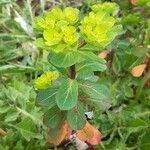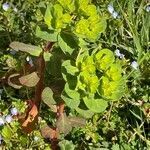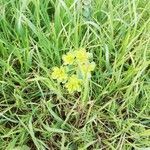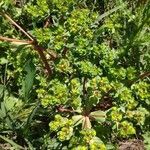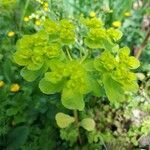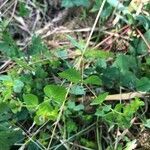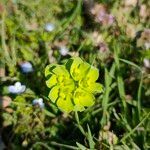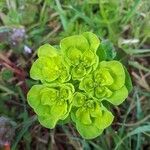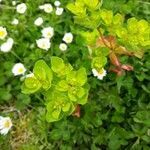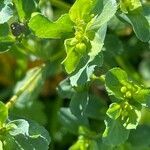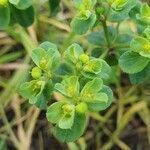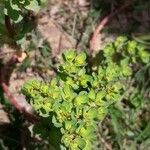Herbs, annual, with taproot. Stems erect, unbranched or branched, 5–45 cm, usually glabrous or sparsely pilose. Leaves: petiole absent or to 0.5 mm; blade obovate-spatulate, 4–40 × 2–25 mm, base cuneate, attenuate, or auriculate, margins serrulate, apex rounded, surfaces glabrous; venation pinnate, midvein prominent. Cyathial arrangement: terminal pleiochasial branches (3–)5, each 1–2 times 2-branched; pleiochasial bracts obovate, wider than distal leaves; dichasial bracts distinct, obovate or rhombic, ± oblique, base rounded, truncate, or attenuate, margins serrulate, apex rounded; axillary cymose branches 0. Cyathia: peduncle 0.2–1 mm. Involucre cupulate, 1.5–2 × 0.7–1.1 mm, glabrous; glands 4, elliptic, 0.2–0.5 × 0.5–1 mm; horns absent. Staminate flowers 10–15. Pistillate flowers: ovary glabrous; styles 0.7–1 mm, 2-fid. Capsules depressed-globose, 2.5–4 × 3.2–4.2 mm, clearly 3-lobed; cocci rounded, smooth, glabrous; columella 0.9–1.1 mm. Seeds dark brown to blackish, subovoid, 1.6–2.2 × 1.5–1.9 mm, reticulate; caruncle elliptic, 0.9–1.1 × 0.4–0.5 mm.
Erect annual. Stems glabrous or sparsely hairy, simple or with a few lower branches, up to c. 50 cm high. Lvs alternate, glabrous, exstipulate, sessile, serrate toward apex, obovate and long-cuneate to base, usually rounded at apex, rarely subacute, (10)-20-40-(60) mm long. Terminal umbel 3-5-rayed, usually with no axillary rays below on each stem; lvs subtending umbel similar to stem lvs but usually broader and less cuneate; rays often secondarily branched and then forming compound dichasia; lvs subtending ray-branches and cyathia similar to stem lvs but much smaller and less cuneate, sometimes elliptic, conspicuous yellow-green. Glands elliptic, entire. Capsule smooth, deeply grooved, with keel rounded or slightly ridged. Seeds reticulate-rugose, rounded, dark brown, c. 2 mm long.
Annual, smooth or nearly so, 2–5 dm, the upper internodes progressively longer; cauline lvs spatulate, 1.5–5 cm, very blunt or retuse, finely and sharply serrulate; lvs subtending the primary umbel somewhat oblique, broadly elliptic to obovate; rays of the primary umbel 5, on well grown plants repeatedly branched; involucres 2 mm; fr smooth, 3 mm; seeds ovoid, 2–2.5 mm, conspicuously areolate; 2n=42. Native of Europe; intr. abundantly from e. Kan. to w. Ont., n. Mich., and N.Y., and occasionally elsewhere. Apr.–Sept. (Tithymalus h.; Galarhoeus h.)
Bisexual, short-lived, glabrous, perennial herb, 0.15-0.30 m high. Leaves 12-32 x 6-25 mm, denticulate, usually sessile, stipules absent. Cyathia in terminal umbel 50-150 mm in diam., around solitary ± sessile cyathium, yellowish green; glands 4, with 2 slender spreading horns on outer margins. Flowering time Apr.-Oct. Capsule 3-4 mm in diam., obtusely 3-angled, glabrous, exserted for 3-5 mm.
A short annual herb. The stems are usually single and hairy. The leaves are oval and broadest above the middle. There are fine teeth on the top half. The flower is an umbel with 5 rays. The bracts are yellow. The fruit is a capsule 2.5-3.5 mm long. It is smooth and does not have wings. The seeds are brown and netted.
Erect annual herb, up to 300 mm tall. Leaves simple, sessile, obovate, glabrous, margins closely serrate in upper half. Flowers in terminal umbels of branched cymes. Capsules 3 mm long. Flowers greenish yellow.
